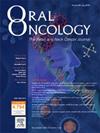三维超声在经口口咽鳞状细胞癌机器人手术中术中肿瘤边缘评估的可行性:一项初步研究
IF 4
2区 医学
Q1 DENTISTRY, ORAL SURGERY & MEDICINE
引用次数: 0
摘要
口咽鳞状细胞癌(OPSCC)经口机器人手术(TORS)后边缘闭合是常见的,因为解剖边界狭窄,需要额外的放射治疗(RT)。超声(US)可以在术中用于区分肿瘤和健康组织。我们的目的是利用一种新的3D超声方法,将肿瘤和边缘测量与组织病理学相关联,探索OPSCCs手术标本的离体超声。方法纳入主要或作为挽救性手术的OPSCC患者。术后立即在手术室进行离体超声,获得三维超声模型。然后由四名对组织病理学不知情的外科医生对美国图像进行分析,以进行相关性分析。计算了使用2 mm阈值对闭合边缘或自由边缘进行分类的准确性。结果纳入9例OPSCC患者(中位年龄63岁,6例男性,5例既往RT, 5例人乳头瘤病毒阳性)。US和组织病理学与肿瘤(r = 0.84-0.85)和切缘测量(r = 0.76-0.78)高度相关。与组织病理学相比,US测量深边缘的平均差异为0.5 mm (SD: 1.2 mm),检测手术标本边缘较近的区域(< 2mm)的灵敏度为80%。在89%的手术标本中,US正确地分类了深缘状态,而在侧缘中,这一比例为44%。结论该概念验证研究表明,体外3D US在OPSCCs TORS术中评估深部手术缘是可行的。本文章由计算机程序翻译,如有差异,请以英文原文为准。

Feasibility of 3D ultrasound for intraoperative tumor margin assessment in transoral robotic surgery for oropharyngeal squamous cell carcinoma: A pilot study
Introduction
Close margins after transoral robotic surgery (TORS) in oropharyngeal squamous cell carcinoma (OPSCC) are common due to narrow anatomical boundaries, requiring additional radiotherapy treatment (RT). Ultrasound (US) can be used intraoperatively to distinguish tumors from healthy tissue. Our objective was to explore ex vivo US of surgical specimens from OPSCCs using a novel 3D US method to correlate tumor and margin measurements with histopathology.
Methods
Patients with OPSCC undergoing TORS either primarily or as salvage surgery were included. Ex vivo US was performed immediately after resection in the operation room and 3D US models were obtained. The US images were then analyzed by four surgeons blinded to histopathology for correlation analyses. The accuracy to classify close or free margins using a 2 mm threshold was computed.
Results
Nine patients with OPSCC were included (median age 63 years, six males, five with previous RT, and five were Human Papillomavirus-positive). US and histopathology had a high correlation for tumor (r = 0.84–0.85) and margin measurements (r = 0.76–0.78). US measured deep margins with a mean difference of 0.5 mm (SD: 1.2 mm) compared to histopathology and had 80% sensitivity to detect areas of the surgical specimens with close margins (<2 mm). US correctly categorized the deep margin status in 89% of the surgical specimens, compared to 44% for the lateral margins.
Conclusions
This proof-of-concept study shows that ex vivo 3D US is feasible for intraoperative evaluation of deep surgical margins during TORS of OPSCCs.
求助全文
通过发布文献求助,成功后即可免费获取论文全文。
去求助
来源期刊

Oral oncology
医学-牙科与口腔外科
CiteScore
8.70
自引率
10.40%
发文量
505
审稿时长
20 days
期刊介绍:
Oral Oncology is an international interdisciplinary journal which publishes high quality original research, clinical trials and review articles, editorials, and commentaries relating to the etiopathogenesis, epidemiology, prevention, clinical features, diagnosis, treatment and management of patients with neoplasms in the head and neck.
Oral Oncology is of interest to head and neck surgeons, radiation and medical oncologists, maxillo-facial surgeons, oto-rhino-laryngologists, plastic surgeons, pathologists, scientists, oral medical specialists, special care dentists, dental care professionals, general dental practitioners, public health physicians, palliative care physicians, nurses, radiologists, radiographers, dieticians, occupational therapists, speech and language therapists, nutritionists, clinical and health psychologists and counselors, professionals in end of life care, as well as others interested in these fields.
 求助内容:
求助内容: 应助结果提醒方式:
应助结果提醒方式:


